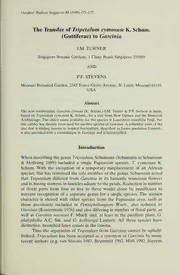
The transfer of Tripetalum cymosum K. Schum. (Guttiferae) to Garcinia … PDF
Preview The transfer of Tripetalum cymosum K. Schum. (Guttiferae) to Garcinia …
Gardens'Bulletin Singapore51 (1999) 175-177. The Transfer of Tripetalum cymosum K. Schum. (Guttiferae) to Garcinia TURNER I.M. Singapore Botanic Gardens, 1 Cluny Road, Singapore 259569 AND STEVENS P.F. Missouri Botanical Garden, 2345 Tower Grove Avenue, St. Louis, Missouri 63110, USA Abstract The new combination Garcinia cymosa (K. Schum.) I.M. Turner & P.F. Stevens is made, based on Tripetalum cymosum K. Schum., for a tree from New Guinea and the Bismarck Archipelago. The oldest name available for the species is Leuconotis tenuifolia Engl, but this epithet has already been used for another species of Garcinia. A columnar form ofthe tree that is finding success in tropical horticulture, described as formapendulum Lauterb., is also provided with a combination in Garcinia and is lectotypified. Introduction When describing the genus Tripetalum, Schumann (Schumann in Schumann & Hollrung 1889) included a single Papuasian species, T cymosum K. Schum. With the exception of a temporary misplacement of an African species, this has remained the sole member of the genus. Schumann noted that Tripetalum differed from Garcinia in its basically trimerous flowers and in having stamens in fascicles adnate to the petals. Reduction in number of floral parts from four or five to three would alone be insufficient to warrant recognition of a separate genus for a single species. The stamen character is shared with other species from the Papuasian area, such as those previously included in Pentaphalangium Warb., also reduced to Garcinia (Kostermans 1976) and also differing in number offloral parts, as G well as Garcinia warrenii F. Muell. and, at least in the pistillate plant, G platyphylla A.C. Sm. and hollrungii Lauterb. All these species have distinctive, branched latex canals in the lamina. Thus the separation of Tripetalum from Garcinia cannot be upheld. Indeed, Tripetalum has been accepted as a synonym of Garcinia by many recent authors (e.g. van Steenis 1987, Brummitt 1992, Hoft 1992, Stevens 176 Gard.Bull.Singapore51 (1999) 1995, Mabberley 1997) but surprisingly the formal transfer of the only species in the genus, Tripetalum cymosum, to Garcinia has not yet taken place. As the new combination is required for a forthcoming checklist of the plants cultivated in the Singapore Botanic Gardens, this deficiency is dealt with here. A New Combination in Garcinia The earliest available name for the species appears to be Leuconotis tenuifolia Engler. The holotype of Leuconotis tenuifolia was lost in the destruction of the Berlin Herbarium during the war, but a fragment of the type is available in the herbarium ofWroclaw University. This consists of a single leaf, small piece of stem and a drawing of a fruit. The leaf, when viewed in transmitted light, has a branching system of latex canals typical of Tripetalum cymosum. The specimen is actually annotated as Garcinia tenuifolia Engler, but this name was never published and the combination has subsequently been pre-empted by Ridley's use ofthe name for a species from the Malay Peninsula. & Garcinia cymosa (K. Schum.) I.M. Turner P.F. Stevens, comb. nov. Basionym: Tripetalum cymosum K. Schum. in K. Schum. & Hollrung, Fl. Kais. Wilh. Land (1889) 51. Type: New Guinea, island near Hatzfeldthafen, M. Hollrung384, November 1886 (holotype, B - destroyed). Leuconotis tenuifolia Engl., Bot. Jahrb. 7 (1886) 470, non Garcinia tenuifolia Ridl. (1928). Type: New Britain, Blanche Bay at 500 m, F.C. Naumann s.n., 16 August 1875 (holotype, B - destroyed; isotype, WRSL - fragment). The Columnar Form of the Tree Some trees ofthis species have pendulous branches resulting in a columnar crown form rather than the typical conical crown. These were described by Lauterbach (1923) as Tripetalum cymosum formapendulum. Peekel (1984) reported that the columnar trees grown in villages in the Bismarck Archipelago did not grow uniformly to type from seed - some seedlings reverting to wild type or intermediate forms. Intergradation in the crown architecture among individuals argues against recognising the columnar tree at a formal taxonomic rank. However, this tree is now being used in tropical landscape planting, e.g. Singapore, and horticulturists require a name for this entity. A cultivar name may be appropriate, viz. Carallia brachiata 'Honiara' (Wong & Whitmore 1994), but it is more expedient to Garciniacymosa 111 transfer the forma to Garcinia and use that for the cultivated plant, at least in the interim. Interestingly, the columnar form in cultivation in Singapore does remain true to type when grown from seed (Mrs Kartini Omar-Hor, pers. comm.). & Garcinia cymosa (K. Schum.) I.M. Turner P.F. Stevens forma pendula (Lauterb.) I.M. Turner & P.F. Stevens, comb. nov. Basionym: Tripetalum cymosum K. Schum. formapendulum Lauterb., Bot. Jahrb. Syst. 58 (1923) 44, sphalm. pendula. Syntypes: Bismarck Archipelago, New Britain, Vunapope, G. Peekel 809d, August 1911; Vakabur, G. Peekel 809b, August 1911 (lectotype, selected here, WRSL). References Brummitt, R.K. 1992. Vascular Plant Families and Genera. Royal Botanic Gardens, Kew. Hoft, R. 1992. Plants of New Guinea and the Solomon Islands: dictionary of the genera and families of flowering plants and ferns. Wau Ecology Institute Handbook. 13: 1-166. Kostermans, A.J.G.H. 1976. Notes on Clusiaceae ofSri Lanka and reduction of Pentaphalangium Warb. Ceylon Journal of Sciences (Biological Sciences). 12: 55-71. Mabberley, D.J. 1997. The Plant-Book. 2nd Edition. Cambridge University Press, Cambridge. Peekel, P.G. 1984. Flora ofthe BismarckArchipelagoforNaturalists. Transl. E.E. Henty. Office of Forests, Lae. Schumann, K. and M. Hollrung. 1889. Die Flora von Kaiser Wilhelms Land. Steenis, C.G.G.J. van. 1987. Checklist ofGeneric Names in Malesian Botany (Spermatophytes). Flora Malesiana Foundation, Leiden. Stevens, P.F. 1995. Guttiferae subfam. Calophylloideae. Handbooks ofthe Flora ofPapua New Guinea. 3: 61-126. Wong Yew Kwan and T.C. Whitmore. 1994. Carallia brachiata cv. Honiara, a beautiful fastigiate ornamental tree. Gardens' Bulletin, Singapore. 46(2): 93-98.
